At Pixar Studios, the 'Toy Story' team introduces new friends and a creepy baby doll villain.
As the great Randy Newman once sang, "When the road looks rough ahead and you're miles and miles from your nice warm bed, you just remember what your old pal said, 'Boy, you've got a friend in me.'"
More than 20 years after that track became the theme song for Toy Story, the lyrics prove particularly prophetic with the upcoming release of Toy Story 4. The latest installment in the film series involves a road trip in which Woody (voiced by Tom Hanks), finding himself lost out in the world, reunites with an unexpected old friend: Bo Peep (Annie Potts).
"We're still working on it," director Josh Cooley told a group of reporters, ET included, during a visit to Pixar Animation Studios last month. Cooley (who previously scripted Inside Out) added this disclaimer before screening a selection of footage from the film, some of which was still in progress. "It will look amazing, way better than this, [and] it will all sound great with Randy Newman's score at the end of the day."
"The other caveat is you're not going to see a ton of Buzz Lightyear in these clips," Cooley added about Tim Allen's beloved space ranger. "He plays a major role in this film, but you won't be seeing all of that today."
Instead, the footage focused on introducing Bonnie's new favorite toy, Forky, which she crafts out of a spork and some pipe cleaners; the road trip, during which Woody and Forky get separated from the rest of the gang and end up bumping into Bo, discovering she has embraced life as a lost toy; and winding up in a dusty antique mall, where Woody crosses paths with a creepy baby doll, Gabby Gabby, who takes a keen interest in his voice box.
During a sitdown in one of Pixar's conference rooms, Cooley, as well as producers Mark Nielsen and Jonas Rivera, discussed thinking outside the (toy) box, dreaming up new characters and reintroducing beloved oldies and why the world needs a Toy Story 4.
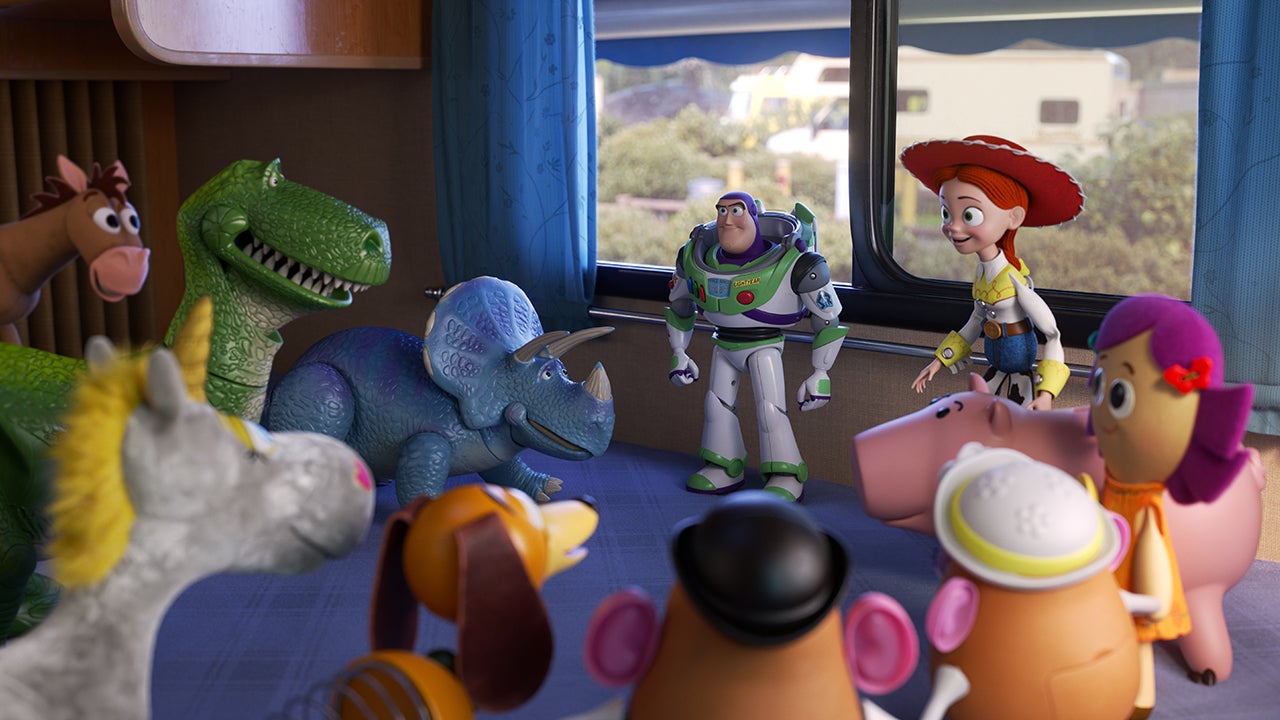
Continuing the Franchise
Toy Story 3 had a real sense of finality. When moving forward with Toy Story 4, how were you able to find a story that felt natural and not forced?
JOSH COOLEY: That's the question of all questions. [Laughs] We loved the end of Toy Story 3. It ends Woody and Andy's story perfectly. We realized there was more story to tell to continue Woody's story. Once we started going down a path and started realizing, "Oh, there is more to tell for Woody," we just kept going and we hit upon something that was worth telling.
MARK NIELSEN: The idea of Bo Peep was so intriguing to us. This movie has been code-named "Peep" here within the walls for the whole four years we've been making it, because we knew she was such an important character in this one. And the idea of them coming back together after not seeing each other for nine years, and what's become of her, was something we thought was really worth exploring.
What does it mean to you to make an audience for such a wide audience? On one side, you have kids and on the other side, you have people who were themselves kids when they saw the first movie and have been following the franchise for all these years.
COOLEY: It's a big responsibility. All of our films here we try to make for everybody, but I know there's a deep love for Toy Story, and we didn't take that lightly at all. From Day 1, we were like, "This is really important and we want to make sure we're doing right by the characters and doing right by the fans and the audiences." And we're the biggest fans, as well. We wanted to make sure we were carrying this story forward in the right way.
JONAS RIVERA: The three of us grew up here, basically. I worked on the first one as an intern. Half of my life has been with these characters, so we feel a tremendous sense of responsibility for 'em. It's core to everything at this studio, so I'll echo Josh that we've never really thought about these as movies for kids. We just think about them as movies, and we try to make it that everyone will enjoy them.
Because that's the kind of movies we grew up seeing. We just take a tremendous amount of pride in it. It's all we think about. And some of the people working on this movie have said, "The first movie I saw was Toy Story, so I don't want to mess it up!" That's what we want! So, it's a real mix of veterans and newer people that feel the same sense of responsibility for it. So, we just do our best to do what we would want to see.
NIELSEN: There is such a deep love within this studio for these characters. Everyone was like, "If we're doing this, it has to be great. We've got to give it everything we've got to make sure it's worthy." We had that level of commitment really from everybody on the crew, from story right on down to rendering.
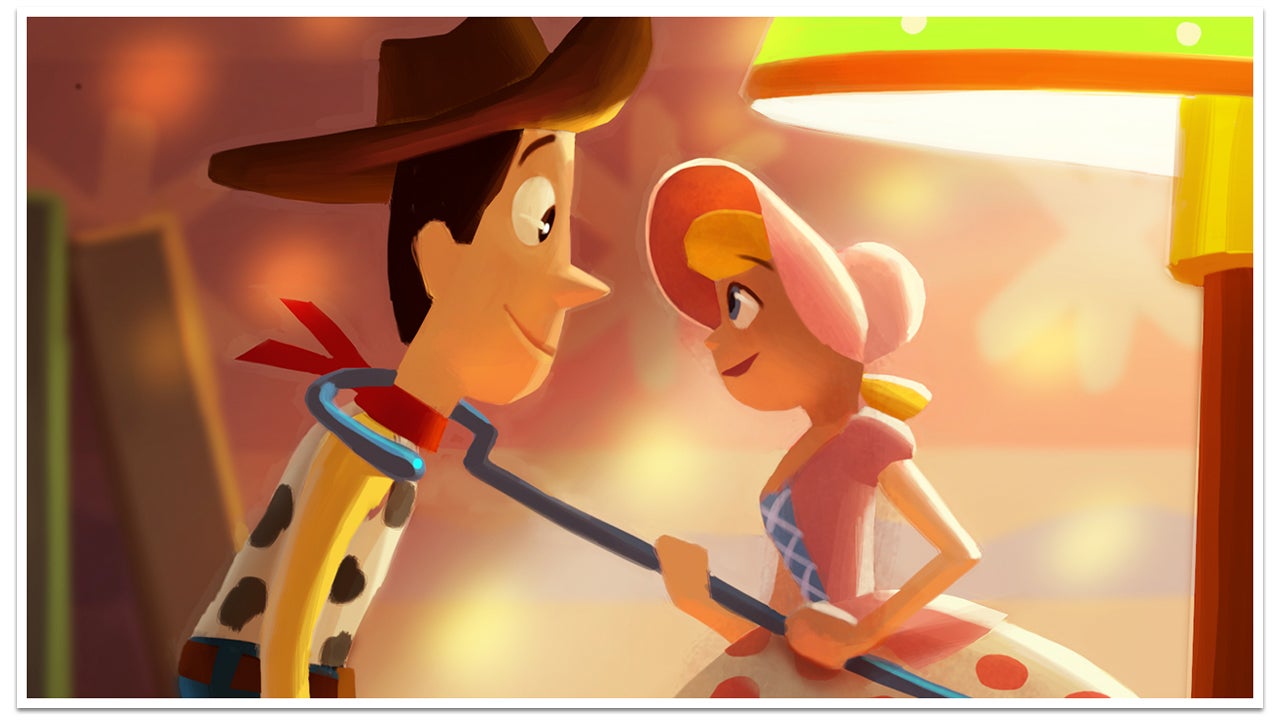
Not Just a Love Story
When John Lasseter originally announced this movie, it was going to be a love story between Bo Peep and Woody. That's obviously changed, but how much of a love story is still baked into this movie?
COOLEY: Woody and Bo have this relationship from the previous films, and so there's definitely an element of that. But it was clear that it couldn't just be that. It would become a tiny people movie, as opposed to a Toy Story film. So, there's a ton of adventure in it. I think of, like, Raiders of the Lost Ark isn't a love story, but it has that great romantic element in it. I think of it more like that.
We heard that you came upon the idea of the movie really being about lost toys about two years ago. As this project's been in development for five years or more, could you talk about how the story has evolved?
COOLEY: Oh, man. Let's see. I'm trying to think of early versions of it. Bo Peep was always part of it, but she was always either in an antique store or she had a location that was kind of like her home. Making her the thing that Woody has always been the most afraid of was really interesting, so she has a completely new worldview that's different from Woody's. But I can't remember any specifics.
RIVERA: It was rooted in its romantic comedy roots. And you're right, we started feeling like, "That just feels like it's a human story." And although she was a worthy character and there was something that was interesting to us about paying off their relationship, it wasn't until we started going, "Well, if you made it Woody-centric, his worst fear -- he said it all along -- is to be a lost toy. What if she represented something that would challenge his place in the world and just, like, lean into that?" It was almost even a Lady and the Tramp analogy of, once out in the world, [saying], "Why wouldn't you want all this?" And the other ones [saying], "No, I want to be at home." And Woody is that. So, all the change he's done over the years, we thought she had the potential to change him more than anything ever has.
COOLEY: And once we figured that was the place to go, I think Jonas, you coined this phrase that was, "If you were to ask Woody as a character, 'What was the biggest moment of your life?' he would say, 'It was when I met Bo Peep for the second time.'" That was our goal for this film, was to make this meeting of her so powerful that it was deserving of Toy Story 4.
What makes a Toy Story film now so much is about Woody and Buzz and their relationship, and what we've seen of this movie is Woody and Bo and Woody and Forky. We know Buzz plays a pivotal role, so what can you tell us about the evolution of Woody and Buzz's relationship as this film progresses and as Woody learns new things along the way?
COOLEY: I can't tell you anything. [Laughs] You could not make this movie without Buzz and their relationship, so the thing that is really, I think, one of the coolest things is having that first film, where their relationship begins and you're seeing how it evolves over the course of two and three, and then four just continues that, and it really does build upon what's been before it.
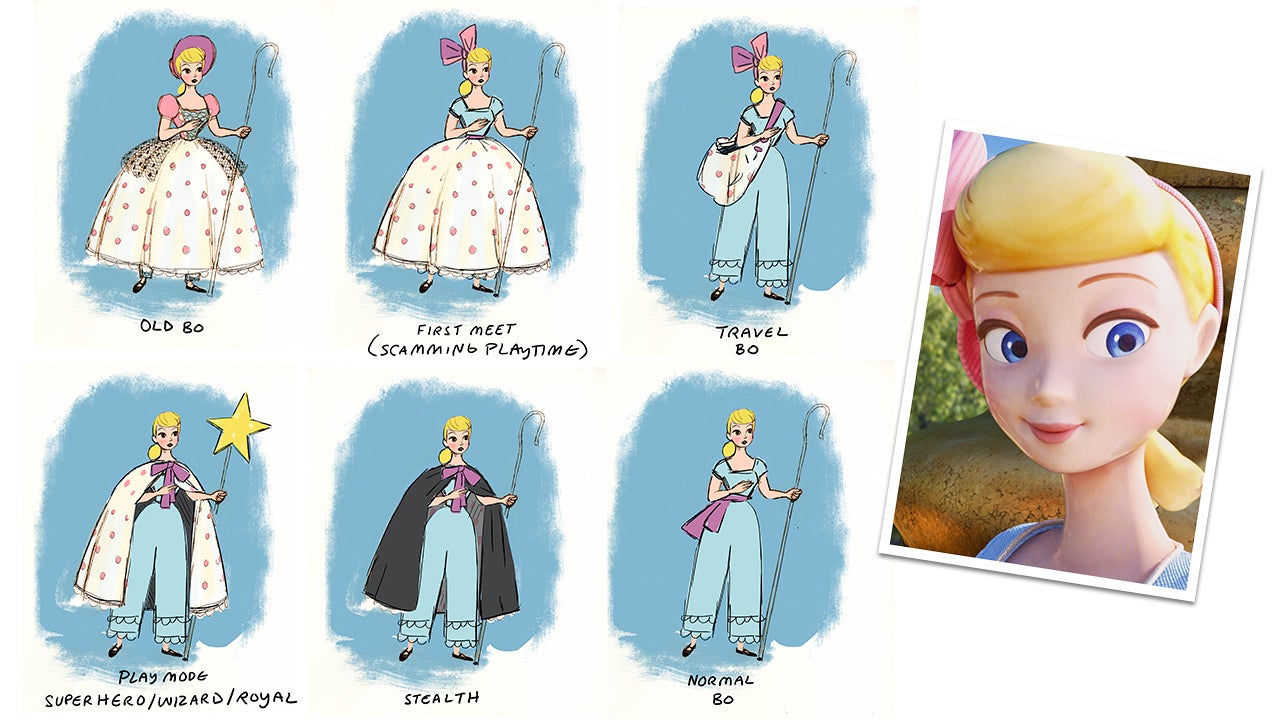
Bo Peep Is Back
Annie Potts' flirty shepherdess Bo Peep was last seen in "Toy Story 2," more that two decades ago. A lot has changed since then, and the porcelain damsel is no longer in distress when she returns as a bo staff-wielding action heroine.
There's been a renaissance in romantic comedies where we've recognized that women haven't often had their own agency in the films. What are you doing to make sure that doesn't happen to Bo? And have you had any feedback from the female creatives in creating her story?
NIELSEN: Yeah, "Team Bo" is what we called the group within the team. It was folks from story and from art and from animation and cloth that really rallied around the idea of keeping Bo as a really special and unique standout character that didn't fall into tropes or anything that you typically see in an action film. It was important to us -- very important to us -- that Bo had a different worldview than Woody. And you said romantic comedy, [but] pretty earlier on in our process, we sort of decided to steer away from that and back toward more of an adventure that had a lot of humor in it, more along the lines of [an] Indiana Jones type of film and away from romantic comedy. But we were really happy with the way that the Bo-Woody relationship landed.
Does she have her own arc, separate from Woody?
NIELSEN: She absolutely has her own arc. We can't wait to share the rest of the movie and let you see what happens with Bo.
RIVERA: I'll only add, because you asked, Did we get feedback from that group? The answer is yes. We did. They would unflinchingly say, down to like, "She wouldn't hold herself that way." Or "That line is a little off." Even Annie Potts would help steer it.
COOLEY: It was great. I loved it.
RIVERA: You would say, "This is the shape of the scene and how we want to dramatize it," but that group would throw a flag on the field if they felt that it was going one way or another or getting too cemented to Woody's point of view and so forth.
NIELSEN: We got to show the film to Annie Potts recently, and her reaction to seeing Bo was really strong. I mean, she absolutely was so happy with the way that this character turned out and the way Bo is represented in the film.
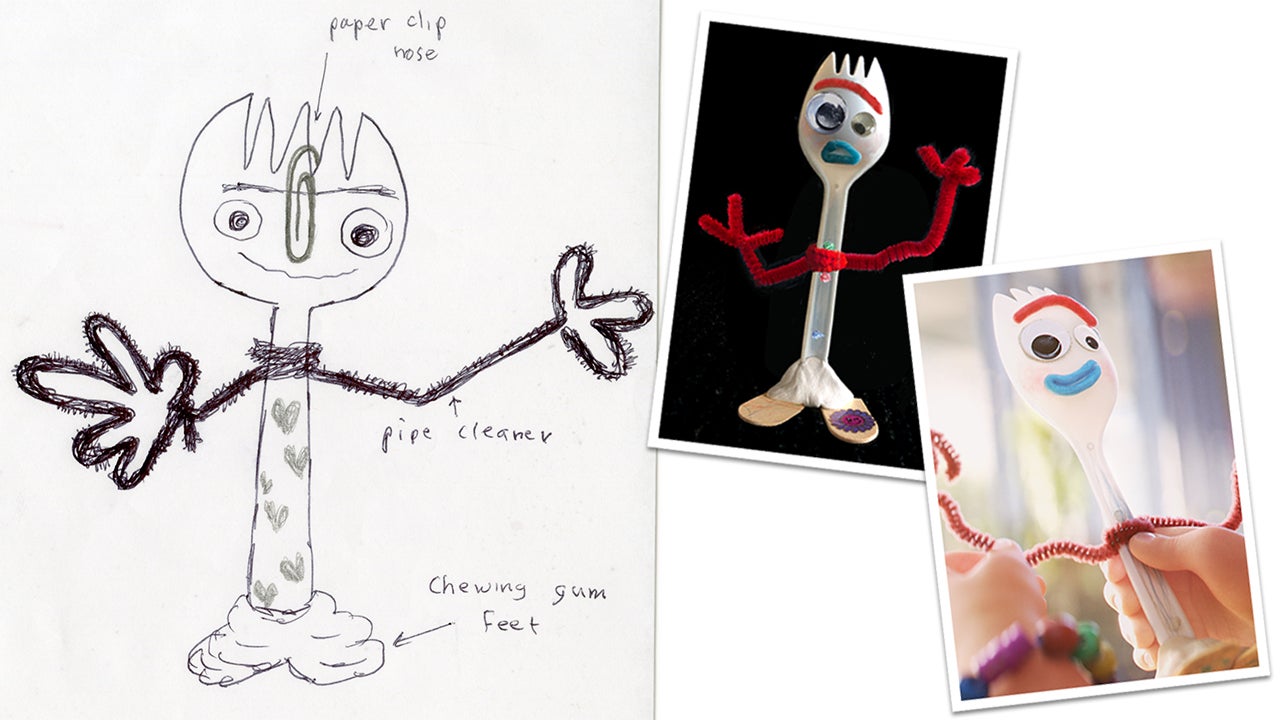
Introducing Forky the Spork-y
Forky (voiced by Tony Hale) is Bonnie's preschool arts and craft project-turned-favorite toy, a sudden status change that causes the glitter-covered spork to suffer an existential crisis. Is he really a toy? Or just trash?
This is a world-building/rules question, but with the introduction of Forky, how do you decide what does and does not constitute a toy and how that thing gains sentience or doesn't gain sentience?
COOLEY: That's a great question. I don't want to answer it. [Laughs] No, it's funny. From Day 1, it was kind of just like, whatever feels right. Even in the first Toy Story, there's a line where they say, "The lawn gnome across the street hasn't seen 'em." It's like, we don't see that, but there are things that are alive in the world that we just never answer the question, [because] I feel like it's a little bit of a Midi-chlorian question of, like, "Explain why that happens." It's like, "Eh...Because."
RIVERA: It did make us laugh, though. One thing I remember kicking around was that idea of kids at Christmas will sometimes open a toy and then play with the box more. We thought, if you were a toy, that would be the worst insult of your life. So, something about that amplified Woody's feeling replaced, like, by the dumbest thing, in a weird way. Really, that's what drove it.
COOLEY: And it's the toy truth of it, right? Like, our kids, they do make craft projects and they play with them, so that would be alive in this world.
RIVERA: Story-wise, I think, it's her writing her name [under Forky's foot].
COOLEY: That's a big part of it. It seals the deal that this is important to her.
Does Forky remember his time before being alive? Why does he keep trying to return to the trash?
RIVERA: He instinctively knows what he is.
COOLEY: He knows what his purpose is.
RIVERA: This cup's purpose is to hold water and it would know that. And [the trash] is, like, home. So, I think it's just his purpose. His gut.
COOLEY: That's what Toy Story is actually built upon, is that everything has a purpose. So, a toy's purpose is to be there for their child. A cup's purpose is to hold water. Being that he's a spork, it's like, soup, salad, chili.
RIVERA: Single use.
COOLEY: So, now he has a whole new purpose and actually that goes down [the line]: Not only is it Forky, but now Woody has a new purpose as well and so does Bo. Everybody reflects that theme of change.
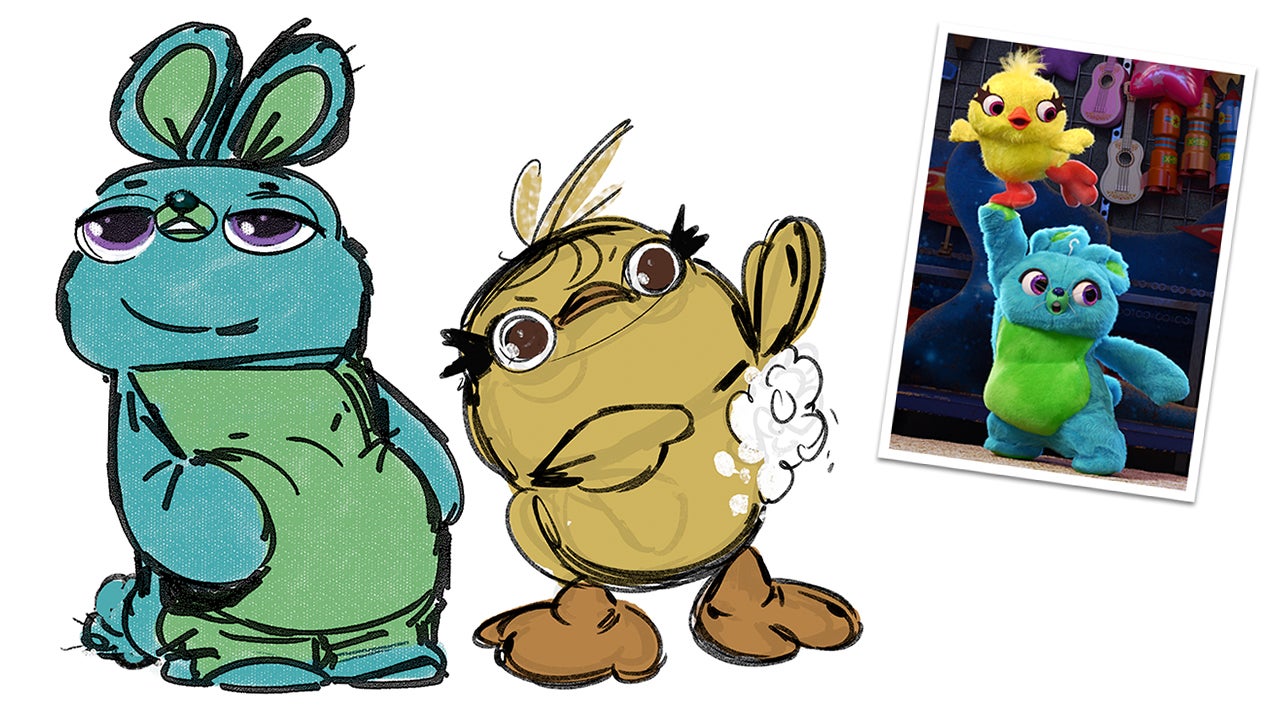
Meet the Carnival Crew
When Forky makes a break for it during Bonnie's family's road trip, Woody chases after him and the two wind up near a town carnival, where Buzz eventually meets Bunny (Jordan Peele) and Ducky (Keegan-Michael Key).
How did you settle on a carnival?
COOLEY: Carnival toys is one of the [reasons]. We're always looking for areas where toys actually do exist in the world to make it feel natural. At first the carnival was kind of like, "Oh, this would be a fun obstacle for these toys." But then we realized it could actually become deeper than that and actually be part of the story. Also, seeing how the lighting of a carnival can affect the mood. During the daytime, they're kind of gross, but at nighttime, they are stunningly beautiful and we deferentially took advantage of that.
NIELSEN: We love the contrast, too, between life with the toys in the antique store and what was just outside. You've got all of these kids running around outside and these toys that are trapped that don't have a kid but desperately want one, and it's just on the other side of the glass.
RIVERA: Remember we were talking about that thing we'd heard on the Alcatraz tour? If you've ever been to Alcatraz, they say the prisoners were kind of going crazy because they could hear people having parties and laughing across the bay. It was, like, a thousand miles away from them, and that was really emotional and interesting and we thought, "Oh, a toy version of that is right outside this antique store. Right there is kids having fun and trying to win toys, and we can't have it." It just amplified all the right themes. Plus, it was fun to expose the toys and really put them in a world. We've been in bedrooms and, of course, schools and things but just to have a little more exposure and try to navigate this place, it all added up to drop it into the story in a right way.
COOLEY: We really did take advantage of the areas of a carnival where people can't go. We went to a lot of carnivals for research trips and it turns out, underneath all of those games is where they store all the crap for taking down everything. So, our toys were able to move through there and could still be hidden, which is pretty fun.
Can you talk about bringing Jordan Peele and Keegan-Michael Key on board? Did you always want them to play the carnival toys, Bunny and Ducky?
COOLEY: Yeah, in fact we recorded them --
RIVERA: Four years ago.
COOLEY: They might have been one of the first. They were on really early, and as the story evolved and changed, they were always a part of it and always there. Watching them perform is one of the [greatest] highlights of working here that I've ever had. Those two guys, they know each other so well. We always recorded them together in the same room, because they just bounce off each other so well. They're hilarious, as we all know, but the thing that blew me away was how they're able to improv but stay on point in the moment and feel like it's not just being funny for funny's sake, but they're supporting the story. Every take was supporting the story. They were a joy to work with.
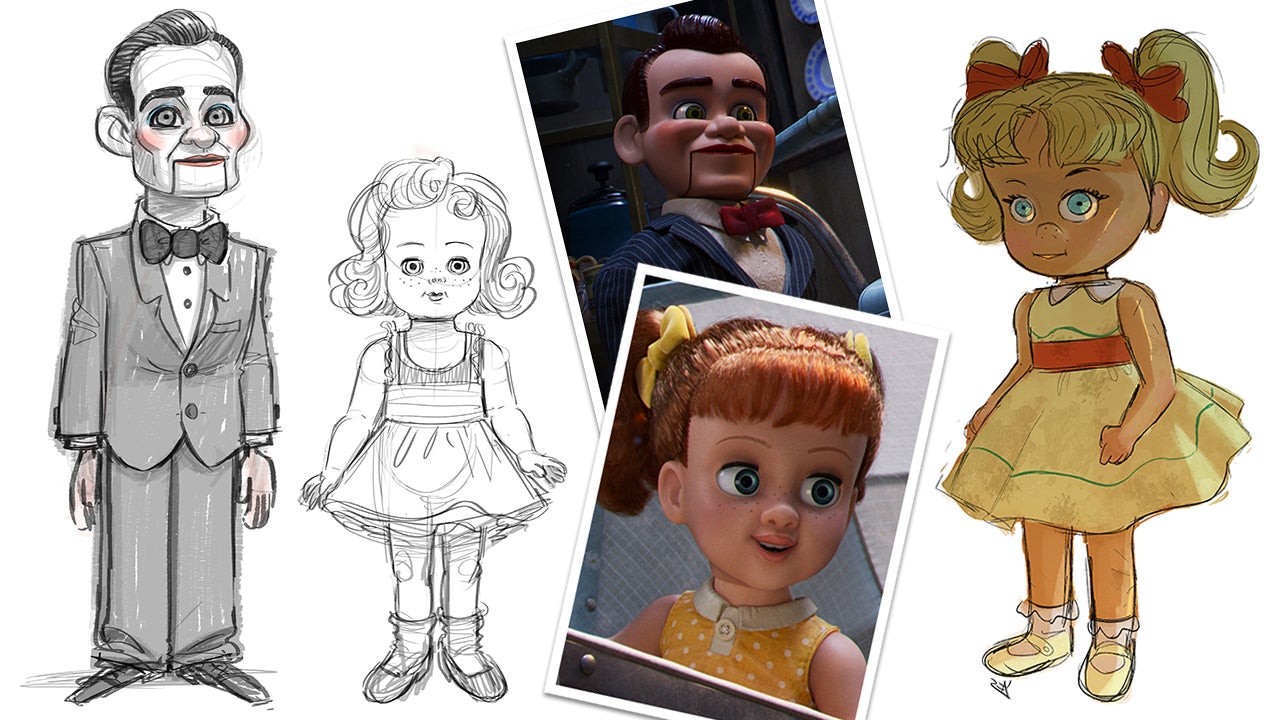
Inside Second Chance Antiques
Along the way, Forky gets trapped inside a spooky antique mall, where the villainous vintage baby doll, Gabby Gabby, has collected a mob of ventriloquist dummies, including her right-hand henchmen, Benson, to do her bidding.
Can you tell us a little bit about Gabby Gabby and Christina Hendricks and her character?
COOLEY: I love this character. We went to a lot of antique stores for reference in this film, and there's always a creepy doll in the corner and, never fails, at least two ventriloquist dummies spread around inside these stores. So, we were like, "Well, that's a perfect villain." We've never done a female villain before. We've never done a baby doll, that I can remember, in the Toy Story films. And then we heard Christina's voice and we're like, "That's even more perfect." We met with her, and in her first recording session, I pitched her the whole story and she said, "This is really great. I actually didn't want Barbie dolls when I was a kid. I used to play with ventriloquist dummies." I was like, "What…?" She said, "Yeah, I did." And she said, "I also have a lot of doll heads in my house right now." I'm like, "Wait, just the heads?!" She's like, "Yeah."
RIVERA: She is Gabby Gabby.
I'm wondering what you were drawing on visually for the ventriloquist dummies themselves. When I saw it, I immediately thought of Slappy from Goosebumps. I'm wondering if you thought of that at all or if there were any real ones that were particularly inspiring?
COOLEY: We do a ton of research on everything, and I know the Slappy one. It's based on the classic one as well. We go through all of these different versions of it. In fact, one of our artists here has an office full of them, and it's terrifying.
RIVERA: No one goes over there. [Laughs]
COOLEY: One of the things we wanted to make different was that the way they move and operate isn't just like a little man running around. We're staying true to the materials. The same way Woody doesn't have any kind of support in his system, these guys, they're not built to stand at all. They're meant to sit on a lap, so their legs crumple underneath them and their arms kind of flop around, which makes them more terrifying and fun.
RIVERA: I also thought that it was funny that the one toy that is actually supposed to talk, they don't.
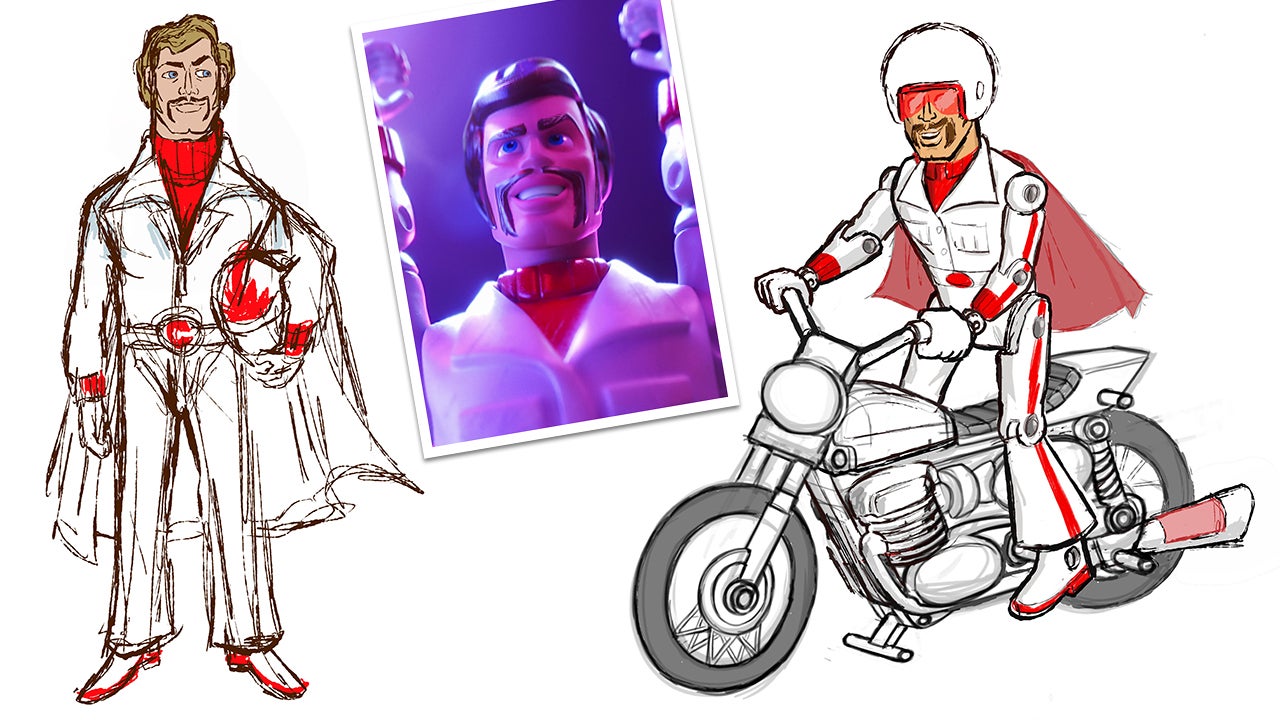
Bo has allies inside the antique store, however, including Canada's greatest stuntman: Duke Caboom, the pint-sized, '70s-inspired daredevil voiced by the equally Canadian Keanu Reeves.
Can we talk a little bit about Keanu Reeves character? Casting a Canadian as a Canadian and playing with that idea of an action hero.
COOLEY: Yes, please! We created Duke Caboom, we always create the character first, and then we see what's the right actor to portray this. And we went after Canadian actors and he was the first one on our list. I'm so thrilled that he said yes. He came here first just to meet with us before even signing, and we were down in the atrium and he's like, [Keanu Reeves voice] "What do you think he sounds like?" And I'm like, "Mhmm!"
RIVERA: Guess who did the scratch voice? [Laughs]
COOLEY: He completely won me over, to the point where we were talking about the character and just getting deeper and he's like, "What do you think drives him?" And he, at one point, just got up on the table in front of everybody and he gets up and goes, "Pow! Bam!" He's doing poses and stuff, and I was like, "This is it. This is incredible." And every time we recorded with him, he just had the biggest smile on his face and it was just so much fun. I can't speak enough about how awesome he is.
RIVERA: He's everything you'd hope Keanu Reeves would be.
NIELSEN: And we didn't know when we brought him here was that he owned his own motorcycle company. Like, his connection to motorcycles was not clear to us until we sat with him and were like, "Whoooa."
RIVERA: We even said, "Maybe we should do the Caboom Cycle like one of yours." He was like, "No, no. The Caboom Cycle is perfect." Or something like that! He even protected the Caboom Cycle that we had.
COOLEY: Real quick, he said, like, "I'm filming John Wick 3." And I'm like, "Oh, how's that going?" And he goes, "I got to kill a guy with a book." [Laughs] "Great!"
Toy Story 4 opens in theaters on June 21.
RELATED CONTENT:
